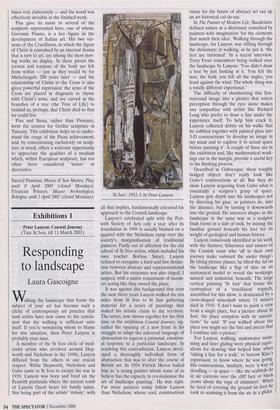Exhibitions 1
Peter Lanyon; Coastal Journey (Tate St Ives, till 11 March 2001)
Responding to landscape
Laura Gascoigne
Walking the landscape that forms the subject of your art has become such a cliché of contemporary art practice that land artists have now come to the conclu- sion that the walking is sufficient unto itself. If you're wondering whom to blame for this situation, then Peter Lanyon is probably your man.
A member of the St Ives circle of mod- ernist artists who revolved around Hep- worth and Nicholson in the 1940s, Lanyon differed from the others in one crucial respect. While Hepworth, Nicholson and Gabo came to St Ives to escape the war in 1939, Lanyon was born and bred on the Penwith peninsula where the ancient tomb of Lanyon Quoit bears his family name. Not being part of the artists"colony', with all that implies, fundamentally coloured his approach to the Cornish landscape.
Lanyon's celebrated split with the Pen- with Society of Arts only a year after its foundation in 1949 is usually blamed on a quarrel with the Nicholson camp over the society's marginalisation of traditional painters. Partly out of affection for the old school of St Ives artists, which included his own teacher Borlase Smart, Lanyon refused to recognise a hard and fast distinc- tion between abstract and representational artists. But his resistance was also tinged, I suspect, with a native resentment of incom- ers acting like they owned the place.
It was against this background that over the next three years Lanyon walked the ten miles from St Ives to St Just gathering material for a series of paintings that staked his artistic claim to the territory. The series, now shown together for the first time in the exhibition Coastal Journey, sig- nalled the opening of a new front in his struggle to adapt the universal language of abstraction to express a personal, emotion- al response to a particular landscape. In resolving this contradiction, Lanyon devel- oped a thoroughly individual form of abstraction that was to alter the course of British art. In 1954 Patrick Heron hailed him as 'a young painter whom some of us believe has the capacity to revolutionise the art of landscape painting'. He was right. Far more painters today follow Lanyon than Nicholson, whose cool, constructivist vision for the future of abstract art ran up an art historical cul-de-sac.
In The Painter of Modern Life, Baudelaire defined nature as a dictionary consulted by painters with imagination 'for the elements that match their idea'. Walking through the landscape, for Lanyon, was riffling through the dictionary; in walking, as he put it, 'the feet are informed'. In a recent interview, Terry Frost remembers being walked over the landscape by Lanyon: 'You didn't draw a tree by just looking at it. You felt the tree, the bark, you felt all the angles, you leant against the wind. The whole thing was a totally different experience.'
The difficulty of shoehorning this Sen- surround image into a picture that enters perception through the eyes alone makes one sympathise with artists like Richard Long who prefer to draw a line under the experience itself. To help him crack it, Lanyon collected debris on his walks that he cobbled together with painted glass into 3-D constructions `to develop an image in my mind and to explore it in actual space before painting it'. A couple of these are in the exhibition and, like mathematical work- ings out in the margin, provide a useful key to his thinking process.
Described as Gaboesque, these roughly bodged objects don't really look like Gabo's constructions at all. But they do show Lanyon acquiring from Gabo what is essentially a sculptor's grasp of space. Lanyon gets depth into his landscapes not by directing his gaze, as painters do, into the distance, but by turning it downwards into the ground. He uncovers shapes in the landscape in the same way as a sculptor finds forms in a slab of rock, by mining the familiar ground beneath his feet for its weight of geological and human history.
Lanyon consciously identified in his work with the farmers, fishermen and miners of the Cornish coast who 'all in their own journey make outward the under things'. By tilting picture planes, he lifted the lid on the landscape like a flap of skin on an anatomical model to reveal the workings, natural and industrial, beneath. The large vertical painting `St Just' that forms the centrepiece of a 'crucifixion' triptych, assembled for this show, is dominated by a cross-shaped mineshaft where 31 miners died in 1919. 'I don't want to paint a view from a single place, but a picture about .St Just, the place complete with its associa- tions,' he said. 'If you walked about the place you might see the bits and pieces that I combine into a picture.' For Lanyon, walking, underwater swim- ming and later gliding were physical equiv- alents for drawing that helped him, when 'taking a line for a walk', to borrow Klee s expression, to know where he was going. His constructions, similarly, were 'a way of doodling — in space — like the seabirds do in air currents over the cliff face or black crows about the tops of chimneys'. When he tired of covering the ground on foot he took to scanning it from the air in a glider.
He was thus engaged in doodling in space when he had the tragic accident that killed him.
Also showing at Tate St Ives are Veronica Ryan: Quoit Montserrat until 11 March 2001, and John Virtue: New Work until 7 Januaiy 2001.



















































































 Previous page
Previous page